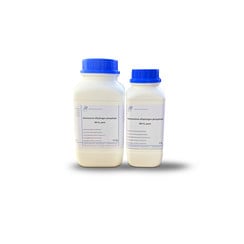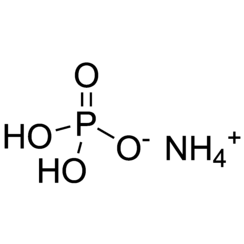You have no items in your shopping cart
Ammonium dihydrogen phosphate
Ammonium dihydrogen phosphate (ADP), also known as monoammonium phosphate (MAP) is a chemical compound with the chemical formula (NH4)(H2PO4). ADP is a major ingredient of agricultural fertilizers and some fire extinguishers. It also has significant uses in optics and electronics.
Uses
Agriculture
The largest use of monoammonium phosphate by weight is in agriculture, as an ingredient of fertilizers. It supplies soil with the elements nitrogen and phosphorus in a form usable by plants. Its NPK label is 12-61-0 (12-27-0), meaning that it contains 12% by weight of elemental nitrogen and (nominally) 61% of phosphorus pentoxide P
2O
5, or 27% of elemental phosphorus.
Fire extinguishers
The compound is also a component of the ABC powder in some dry chemical fire extinguishers.
Optics
Monoammonium phosphate is a widely used crystal in the field of optics due to its birefringence properties. As a result of its tetragonal crystal structure, this material has negative uniaxial optical symmetry with typical refractive indices no = 1.522 and ne = 1.478 at optical wavelengths.
Electronics
Monoammonium phosphate crystals are piezoelectric, a property required in some active sonar transducers (the alternative being transducers that use magnetostriction). In the 1950s ADP crystals largely replaced the quartz and Rochelle salt crystals in transducers because they are easier to work than quartz and, unlike Rochelle salt, are not deliquescent.
Toys
Being relatively non-toxic, MAP is also a popular substance for recreational crystal growing, being sold as toy kits mixed with dyes of various colors.



